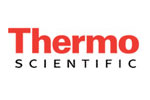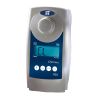Thermo Orion AQUAfast AQ3170 Chlorine Colorimeter
Features
- Convenient scroll-driven menu system
- 16 point internal data storage with date/time stamp
- Waterproof design (IP67)
- Free ground shipping
- Expedited repair and warranty service
- Lifetime technical support
- More
Overview
The Thermo Orion Scientific Orion AQUAfast AQ3170 colorimeter kit measures free and total chlorine in the range of 0.02 to 2.00 mg/L, or 0.1 to 8.00 mg/L with short path-length vial (included). Measuring free and total chlorine using the DPD method, the AQ3170 colorimeter and included reagents assist with EPA drinking water measurement requirements. The colorimeter’s Interference Filter uniquely narrows (targets) the bandwidth, creating accurate and reproducible readings. The included sample vials also help reduce preparation time by utilizing lid-attached light shields instead of a cumbersome sample chamber cover.
Includes
The meter kit includes a field carrying case, sample vials with light-shielding caps, a vial cleaning brush, 100 each of AQUAfast AC4P71 Free Chlorine and AC4P72 Total Chlorine powder reagent packets and batteries. The meter carries a CE certification and a two-year warranty.
- (1) AQUAfast AQ3170 free & total chlorine colorimeter
- (1) Field carrying case
- (1) Set of sample vials with light-shielding caps
- (1) Vial cleaning brush
- (100) AQUAfast AC4P71 free chlorine powder reagent packets
- (100) AQUAfast AC4P72 total chlorine powder reagent packets
- (1) Set of batteries
In The News
Combating Water Insecurity in Saskatchewan with Real-Time Data
The prairies of Saskatchewan can be described as one of the least water-secure parts of Canada, making water quality monitoring essential for informed resource management in a region already facing water insecurity. While natural physical properties worsen some of the poor water quality conditions in the region, others are connected to land use. Having grown up spending summers on the shores of Lake Huron, Helen Baulch, an associate professor at the School of Environment and Sustainability at the University of Saskatchewan , has always been dedicated to the protection of water resources. Looking back fondly at her childhood playing along the shore, Baulch also recalls the invasion of quagga mussels during her teenage years and watching the lake change as a result.
Read MoreSeametrics Turbo Turbidity Logger: Boost your Turbidity Monitoring
The Seametrics Turbo Turbidity Logger is a self-cleaning turbidity sensor capable of internally logging over 260,000 data records. The sensor enables researchers, compliance officers, and contractors to monitor turbidity in various applications, from construction and dredging sites to wastewater effluent. Due to its narrow width, this device can be deployed in a range of areas, from small well spaces to rivers and streams. The stainless steel housing and built-in wiper allow the sensor to withstand long-term deployments and reduce the need for maintenance trips. The logger accurately records temperature and turbidity up to a depth of 50 meters.
Read MoreCollecting Data at the Top of the World: How Scientists Retrieve Glacial Ice Cores
A helicopter touches down in the small town of Sicuani, Peru, at an elevation of 11,644 feet. Earlier that day, a boxcar brought fuel, drills, food, and other equipment for a glacial expedition. The year is 1979, and glaciologist Lonnie Thompson is preparing to lead a team to the Quelccaya ice cap in hopes of becoming the first scientists to drill an ice core sample from this glacier. The only problem? The glacier is located at 19,000 feet in one of the most remote areas of the world. The helicopter takes off from the town, but the thin atmosphere at that elevation does not allow it to safely touch down on the ice– due to the aircraft’s weight, and it becomes unstable when the air is less dense.
Read More












